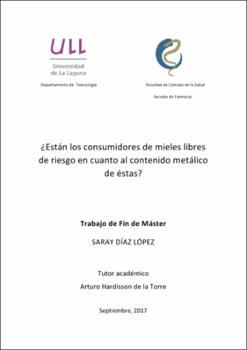¿Están los consumidores de mieles libres de riesgo en cuanto al contenido metálico de éstas?
Autor
Díaz López, SarayFecha
2018Resumen
INTRODUCTION: Honey is a natural product obtained by honey bees from flower nectar or
secretions produced by other living parts of the plants. It is also considered the result of a
process of bioaccumulation of many metals. The amount of macro and microelements within
the honey depends on its botanical origin and the composition of the soil in which the plants
grow. In recent years the metal content in these plants has been related to its existence in the
environment, being therefore used as a bioindicator. On the other hand, honey is a sweet
substance widely used as a sweetener and natural preservative, as well as a very energetic
food product due to its high calorie content, with curative and prophylactic properties.
OBJECTIVES: The objectives of this work are, first of all, to determine through ICP-OES the
concentration of 20 metals (Al, B, Ba, Ca, Cd, Co, Cr, Cu, Fe, K, Li, Mg, Mn, Mo, Na, Ni, Pb, Sr, V,
Zn) contained within honeys produced in the Canary Islands and other honey molasses
commercialized in the island of Tenerife. Secondly, to compare the metal content among all
types of honeys analyzed in the sample, and contrast our results with previous studies. And
finally, to calculate the Recommended Daily Intake (RDI) and the Acceptable Daily Intake (ADI),
considering the recommended limits and maximums established by different institutions.
MATERIALS AND METHODS: A total of 92 samples of different types of honeys, including
honeys produced in the Canary Islands and commercial honeys, have been analyzed by
inductively coupled plasma optical emission spectrometry (ICP-OES) following a process of
drying, acid digestion and Incineration using muffle furnaces.
RESULTS: The results obtained from the samples of honey do not reveal any significantly high
value in terms of the contribution of the metallic intake resulting from honey consumption, for
both Canarian and commercial honeys. On the other hand, the consumption of honey by the
population seems to be quite limited, so we conclude that it does not imply a risk for health.




